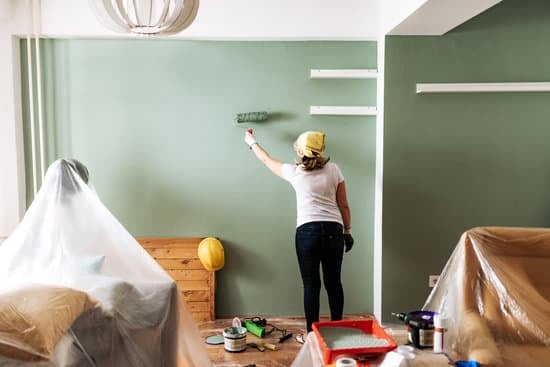Are you wondering how to borrow money for home improvements? Whether you’re looking to add value to your property or simply enhance your living space, making home improvements is a common goal for many homeowners. From kitchen remodels to backyard renovations, investing in your property can not only make it more comfortable but also increase its resale value.
When it comes to financing home improvement projects, there are various options available to homeowners. Understanding these options and how they can benefit you is crucial in making informed decisions for your project.
In this article, we will explore the different types of home improvement loans, tips for qualifying for a loan, and alternative options for financing. By the end of this article, you will have a better understanding of how to secure the necessary funds for your home improvement goals.
Home improvements are important for several reasons. Not only do they enhance the functionality and aesthetics of your living space, but they can also boost the overall value of your property. However, undertaking such projects often requires a significant financial investment that may not be readily available. This is where borrowing money for home improvements becomes essential. Let’s delve into the various loan options and financing alternatives available to homeowners looking to embark on renovation projects.
Types of Home Improvement Loans
When it comes to home improvement projects, finding the right financing option is crucial. There are several types of home improvement loans available, each with its own set of terms and conditions. One of the most common options is a home equity loan, which allows homeowners to borrow against the equity in their property. Another popular choice is a home equity line of credit (HELOC), which functions similarly to a credit card but uses your home as collateral.
For those who don’t have significant equity in their homes or don’t want to use their property as collateral, personal loans can also be used for home improvements. These unsecured loans typically have higher interest rates compared to home equity loans, but they offer more flexibility and don’t require any home equity.
Another option that homeowners may consider is refinancing their mortgage to access funds for renovations. By refinancing, homeowners can take advantage of lower interest rates and potentially free up additional cash for their home improvement projects.
It’s important to carefully consider the pros and cons of each loan option before making a decision on how to borrow money for home improvements, as different loan products will have varying eligibility requirements, interest rates, and repayment terms. And always remember, no matter what type of financing you choose, it’s essential to borrow responsibly and within your means.
| Loan Option | Key Features |
|---|---|
| Home Equity Loan | Borrow against the equity in your property; Fixed interest rate; Lump sum payment |
| Home Equity Line of Credit (HELOC) | Revolving line of credit; Variable interest rate; Flexible withdrawal options |
| Personal Loan | Unsecured loan; Higher interest rate; Flexible use of funds |
| Mortgage Refinance, Lower interest rates; Potential additional cash for renovations, |
Understanding Home Equity Loans and Lines of Credit
What Are Home Equity Loans and Lines of Credit?
Home equity loans and lines of credit are types of loans that allow homeowners to borrow money against the value of their homes. With a home equity loan, you receive a lump sum of money upfront and make fixed monthly payments over a set period of time.
On the other hand, a home equity line of credit (HELOC) works more like a credit card, allowing you to borrow funds as needed up to a certain limit and only pay interest on the amount you use.
How to Qualify for a Home Equity Loan or Line of Credit
In order to qualify for a home equity loan or HELOC, you must have sufficient equity in your home. Lenders typically require that you have at least 15-20% equity after taking into account the current mortgage balance. Additionally, your credit score, income, and overall financial standing will also be considered when applying for these types of loans.
Using Home Equity Loans for Home Improvements
One advantage of using a home equity loan or HELOC for home improvements is that the interest may be tax deductible if the funds are used specifically to improve the property. However, it’s important to carefully consider the risks involved with borrowing against your home, as failure to make payments could result in the loss of your property.
Before choosing this option, it’s crucial to assess your ability to repay the loan and determine if it’s the right choice for your specific financial situation.
Tips for Qualifying for a Home Improvement Loan
Home improvement projects are essential for maintaining and increasing the value of your home. However, these projects can be costly, and many homeowners may need to borrow money to fund their renovations. Qualifying for a home improvement loan is an important step in securing the financing you need for your project. Here are some tips to help you improve your chances of getting approved for a home improvement loan.
First, it’s crucial to have a good credit score when applying for a home improvement loan. Lenders use your credit score to assess your creditworthiness and determine the interest rate they will offer you. A higher credit score can lead to better loan terms and lower interest rates. Before applying for a loan, take steps to improve your credit score by paying off any outstanding debts and ensuring that all of your bills are paid on time.
In addition to having a good credit score, lenders will also consider your income and overall financial situation when evaluating your loan application. Be prepared to provide proof of income, employment history, and any other assets you may have. Having a stable income and low debt-to-income ratio can increase your chances of qualifying for a home improvement loan. Lenders want to see that you have the financial means to repay the loan amount.
Finally, having a clear plan for your home improvement project can also help you qualify for a loan. Be ready to provide details about the scope of work, estimated costs, and timeline for completion.
Having a well-thought-out renovation plan demonstrates to lenders that you are serious about using the funds responsibly and completing the project efficiently. By following these tips, you can improve your chances of qualifying for a home improvement loan and secure the financing needed to make your home renovation dreams a reality.
Comparing Interest Rates and Terms From Different Lenders
When it comes to borrowing money for home improvements, one of the most important considerations is the interest rate and terms offered by different lenders. Comparing these factors can help you find the best financing option for your specific needs.
Researching Lenders: Finding the Right Fit
Before committing to a lender for a home improvement loan, it’s important to research and compare what various lenders have to offer. Look for reputable lenders who specialize in home improvement loans and have a history of providing competitive rates and favorable terms. Consider reaching out to local banks, credit unions, online lenders, and even peer-to-peer lending platforms to explore all of your options.
Comparing Interest Rates and Terms
Once you’ve narrowed down potential lenders, take the time to compare their interest rates and terms. Look beyond the initial interest rate offered and consider factors such as fixed or variable rates, loan terms, any fees or closing costs involved, and whether there are any prepayment penalties. By comparing these details, you can get a clearer picture of which lender offers the most favorable financing options for your home improvement project.
Seeking Pre-Approval
After conducting thorough research and comparing interest rates and terms from different lenders, consider seeking pre-approval from your top choices. This process will provide insight into the specific loan amount you may qualify for along with an idea of what your monthly payments could look like. Remember that obtaining pre-approval does not require you to commit to a specific lender but can help inform your decision-making process when choosing the best financing option for your home improvements.
How to Use a Personal Loan for Home Improvements
If you are considering making improvements to your home but don’t have the cash on hand, taking out a personal loan can be a viable option. Here are some ways in which you can use a personal loan for home improvements:
1. Renovations: Whether you want to update your kitchen, remodel your bathroom, or add a new room to your home, a personal loan can provide the funds needed for these types of major renovations.
2. Repairs: If your home is in need of essential repairs such as fixing a leaky roof, replacing outdated plumbing or electrical systems, or repairing structural damage, a personal loan can help cover these costs.
3. Energy Efficiency Upgrades: Investing in energy-efficient upgrades such as installing solar panels, upgrading insulation, or replacing old windows and doors can not only make your home more comfortable but also save you money on utility bills in the long run.
Using a personal loan for home improvements can provide the flexibility and convenience needed to complete your projects without dipping into your savings or tapping into other sources of funding. However, it’s important to carefully consider the terms of the loan and ensure that you will be able to comfortably make the monthly payments without putting yourself in financial strain.
Pros and Cons of Borrowing Money for Home Improvements
Borrowing money for home improvements can be a smart financial move for homeowners looking to increase the value and comfort of their property. However, it’s important to consider the pros and cons before taking on any type of home improvement loan.
One of the main benefits of borrowing money for home improvements is that it allows homeowners to make necessary upgrades without having to deplete their savings. This is especially helpful for larger renovation projects that require a significant amount of capital. Additionally, using a home improvement loan can potentially increase the value of your property, making it a solid investment in the long run.
On the other hand, there are some downsides to borrowing money for home improvements. One of the biggest drawbacks is the added debt and interest payments that come with taking out a loan. It’s crucial for homeowners to carefully consider whether they can afford the additional monthly expenses before moving forward with a loan.
Another important aspect to consider when thinking about borrowing money for home improvements is the potential impact on your credit score. Taking on more debt could have negative effects on your credit if you’re not able to keep up with payments, so it’s essential to assess your financial situation before committing to a loan.
Lastly, borrowers should also be aware of any fees associated with acquiring a home improvement loan, such as origination fees or closing costs. These additional expenses can add up and affect the overall cost of the loan, so it’s crucial to factor them into your decision-making process when considering different lending options.
Budgeting for Home Renovations
Once you’ve secured a loan for your home improvement project, it’s important to make the most of the funds by budgeting effectively. Proper budgeting involves planning and allocating the funds in a way that maximizes the value and impact of the renovations. This not only helps in ensuring that the loan amount is used efficiently, but also prevents overspending or going over budget.
To start, create a detailed list of all the renovations and improvements you plan to make, along with estimated costs for each item. This will give you a clear picture of where the money needs to be allocated and help in prioritizing essential upgrades. Consider getting quotes from multiple contractors to compare costs and ensure that you have an accurate estimate of how much each renovation will cost.
Another crucial aspect of budgeting for home renovations is setting aside a contingency fund for unexpected expenses. It’s common for renovation projects to uncover issues that were not initially planned for, such as structural problems or hidden damage. Having a buffer fund can help in covering these unforeseen costs without disrupting the overall budget.
Lastly, stick to your budget as closely as possible throughout the renovation process. Keep track of all expenses and regularly review your budget to ensure that you are staying on track. Remember, making the most of your loan means using it wisely and efficiently to enhance the value and comfort of your home.
Overall, proper budgeting ensures that you make the most out of your loan for home improvements, allowing you to visualize your project efficiently while avoiding any financial burdens after completion. By following these tips on how to use your loan effectively through careful planning and diligence throughout renovation process.
Alternative Options for Financing Home Improvements
Government grants and programs can provide an alternative option for financing home improvements, especially for those who may not qualify for traditional loans or may need additional financial assistance. These grants and programs are designed to help homeowners make necessary repairs or upgrades to their homes, with a focus on promoting energy efficiency, safety, and accessibility.
One popular government program is the Federal Housing Administration (FHA) Title I Home Improvement Loan program. This program provides insured loans for homeowners looking to make improvements to their properties. Another option is the Department of Agriculture’s Rural Repair and Rehabilitation Grant, which offers financial assistance to low-income homeowners in rural areas to repair or improve their homes.
In addition, there are various state and local government programs that offer grants and incentives for certain types of home improvements. For example, some states offer energy efficiency grants or rebates for homeowners who make upgrades to their homes that reduce energy consumption. It’s important to research and inquire about these programs in your area to see if you qualify and how you can benefit from them.
When considering government grants and programs for financing home improvements, it’s essential to carefully review the eligibility requirements, application process, and any potential restrictions or limitations. While these options can provide valuable financial support, it’s crucial to understand the terms and conditions associated with each program before proceeding with your home improvement project.
Conclusion
In conclusion, when it comes to making home improvements, there are various options available for borrowing money. Whether it’s through home improvement loans, home equity loans, personal loans, or even grants and government programs, homeowners have the opportunity to make necessary upgrades and renovations to their homes. It’s important to carefully consider each option and weigh the pros and cons before making a decision on how to borrow money for home improvements.
One important factor to consider is the interest rates and terms offered by different lenders. By comparing these aspects, homeowners can ensure they are getting the best deal possible for their loan. Additionally, understanding the qualifications for these loans and having a solid budget in place will help ensure that the renovation process goes smoothly without any financial hiccups.
Ultimately, making informed decisions about borrowing money for home improvements is key to achieving your desired results while also maintaining financial stability. By exploring all available options and considering your own financial situation, you can confidently move forward with your home improvement project and create a comfortable and updated living space for you and your family.
Frequently Asked Questions
What Is a Home Improvement Loan Called?
A home improvement loan can be referred to as a personal loan, home equity loan, or a home equity line of credit (HELOC). These loans are specifically designed to help homeowners finance renovations and improvements to their homes.
Can Renovations Be Loans?
Yes, renovations can be financed through various types of loans such as personal loans, home equity loans, or HELOCs. These options allow homeowners to borrow the money needed for renovations and then repay it over time with interest.
Is It Better to Pay Cash or Finance Home Improvements?
Whether it’s better to pay cash or finance home improvements depends on individual circumstances. Paying cash means avoiding interest payments, but it could deplete savings. Financing allows for spreading out payments but comes with added cost due to interest. It’s important to weigh the pros and cons based on one’s financial situation before making a decision.

I’m thrilled to have you here as a part of the Remodeling Top community. This is where my journey as an architect and remodeling enthusiast intersects with your passion for transforming houses into dream homes.





